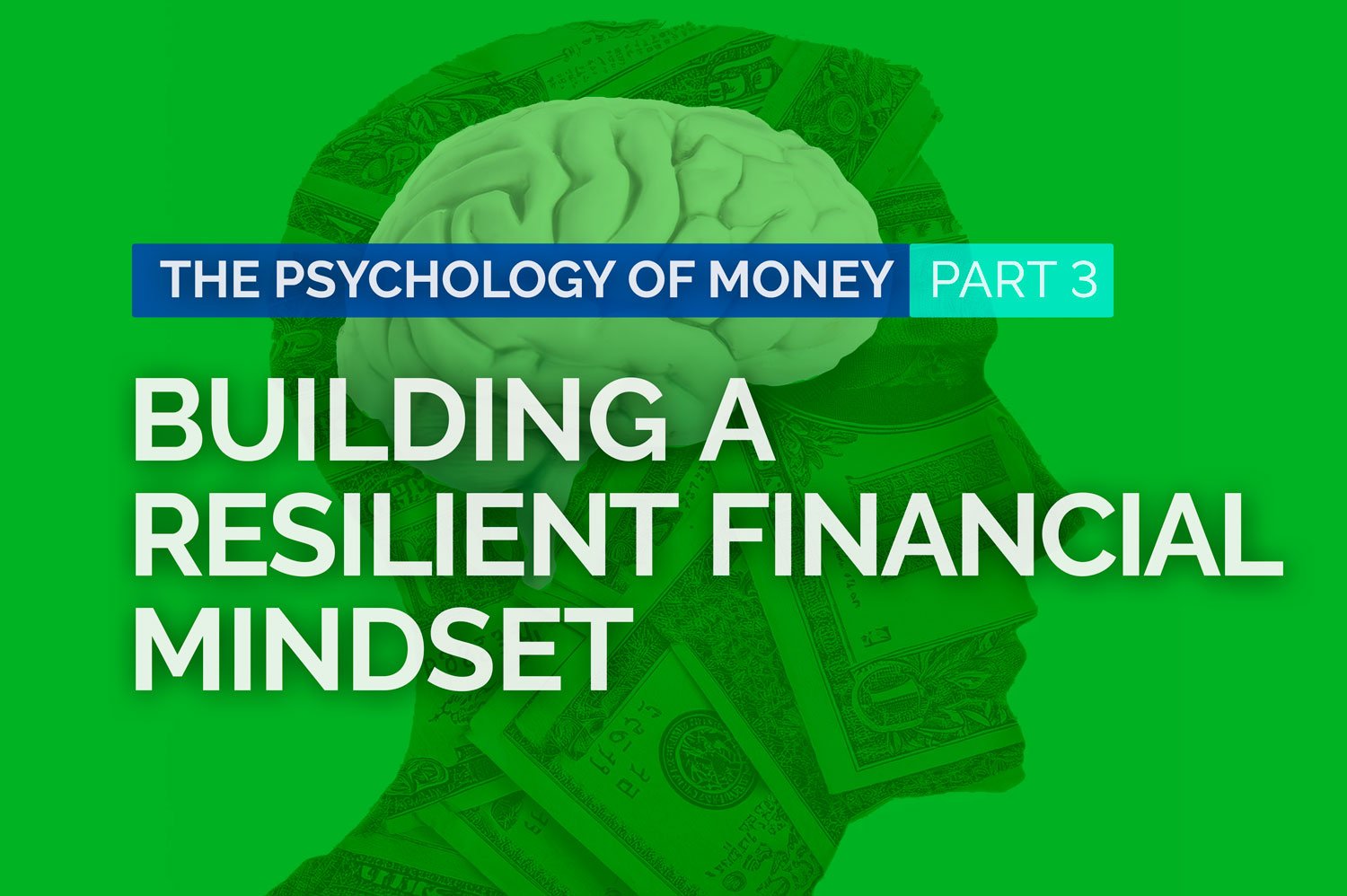Welcome to the final part of our series, “The Psychology of Money.” In the first two parts, we explored the powerful emotions and biases that often drive financial decisions. We learned how emotions like fear, greed, and regret can cloud judgment, leading us to make choices that don’t align with our long-term goals. We also examined common financial biases such as loss aversion and herding behavior, along with strategies for overcoming them.
Now, in this last installment, we’re going to focus on something crucial for your financial journey: building a resilient financial mindset. The road to financial success is rarely smooth, and unexpected challenges—market downturns, personal emergencies, or sudden life changes—are bound to happen. The key to navigating these bumps is resilience.
In this article, we’ll discuss how you can develop financial resilience by adapting to shocks, creating a safety net, and fostering a growth mindset. We’ll also highlight the importance of having a solid financial plan that can evolve with your needs over time. Let’s get started!
Table of Contents
Developing Financial Resilience
Financial resilience is about more than just having a big bank account—it’s about being prepared for whatever life throws your way. Resilience is the ability to adapt, learn, and recover when faced with financial challenges. Whether it’s a market crash or a surprise medical bill, resilience ensures that you’re able to maintain your financial stability and continue working toward your long-term goals.
Adapting to Financial Shocks and Market Volatility
One of the biggest hurdles in personal finance is dealing with market volatility and unexpected financial shocks. Stock markets rise and fall, and economic conditions can change overnight. If you’re unprepared, these fluctuations can cause you to panic, make poor decisions, or abandon your financial plan altogether.
A resilient financial mindset requires you to anticipate market volatility and be emotionally prepared for it. You should recognize that ups and downs are a normal part of investing. Instead of reacting impulsively to short-term losses, it’s essential to stay focused on your long-term objectives. By keeping your emotions in check, you can avoid the trap of selling low and buying high, a common mistake many investors make in times of uncertainty.
Here’s a helpful mindset shift: Instead of viewing volatility as a threat, see it as an opportunity. During downturns, there may be buying opportunities or ways to rebalance your portfolio. The key is not to let fear drive your decisions.
Creating a Financial Safety Net
While a resilient mindset is important, having a financial safety net is equally crucial. No matter how emotionally prepared you are, financial resilience is difficult to achieve without the right resources. This is where emergency funds and insurance come into play.
- Emergency Funds: Life is unpredictable, and unexpected expenses can pop up when you least expect them. Whether it’s a sudden job loss, medical emergency, or home repair, having an emergency fund can prevent you from going into debt or dipping into your long-term investments. Ideally, aim to save three to six months’ worth of living expenses in an easily accessible account.
- Insurance: Insurance is another key component of a financial safety net. Health insurance, life insurance, and disability insurance can protect you and your loved ones from financial devastation in the event of illness, death, or an inability to work. While it may seem like an extra expense now, the peace of mind that comes with being insured far outweighs the cost.
By creating a robust safety net, you’ll be better prepared to handle any financial shocks without derailing your long-term goals.
Fostering a Growth Mindset
To develop true financial resilience, it’s important to foster a growth mindset. A growth mindset means you see challenges as opportunities to learn and grow, rather than as obstacles that hold you back. This mindset can be applied to every aspect of your financial life.

For example, let’s say you experience a significant financial setback, like a market downturn that reduces the value of your portfolio. Instead of panicking or giving up, a growth mindset encourages you to ask: What can I learn from this? How can I adjust my strategy moving forward?
Cultivating a growth mindset can also help you stay open to new opportunities. The world of personal finance is always evolving, and new tools, strategies, and investments are constantly emerging. Instead of being set in your ways, a growth mindset allows you to adapt to changes and seek out opportunities for growth and improvement.
In short, having a growth mindset ensures that you’re always moving forward, even when things don’t go according to plan.
The Importance of Financial Planning
Now that we’ve covered the mental side of financial resilience, let’s talk about the practical side: financial planning. Having a comprehensive financial plan is the foundation of any resilient financial strategy. Your plan should be tailored to your individual needs, goals, and circumstances, and it should be flexible enough to adapt as life changes.

Creating a Comprehensive Financial Plan
A solid financial plan serves as your roadmap to financial success. Without a plan, it’s easy to get off track or make decisions based on short-term emotions or trends. A comprehensive financial plan covers all areas of your financial life, including:
- Saving for Retirement: Determine how much you’ll need to save for retirement based on your desired lifestyle and how many years you plan to be retired. Be sure to consider factors like inflation and potential medical expenses.
- Investing: Your investment strategy should be based on your risk tolerance, time horizon, and financial goals. Diversification is key to reducing risk and maximizing long-term growth.
- Debt Management: If you have debt, your financial plan should include a strategy for paying it down while balancing other financial goals.
- Tax Planning: Tax planning is essential for maximizing your income and minimizing your tax liability. Work with a financial advisor to create a tax-efficient plan.
- Estate Planning: Ensure that your assets are passed on according to your wishes by setting up an estate plan, including a will, trusts, and powers of attorney.
When creating your financial plan, it’s important to think long-term and take a holistic approach. Don’t focus solely on one area of your financial life—balance your short-term and long-term goals to create a plan that’s sustainable.
Regular Reviews and Adjustments
Financial plans are not set-it-and-forget-it. Life changes, and so should your plan. Whether you experience a change in income, unexpected expenses, or a shift in financial goals, regular reviews of your financial plan ensure that you stay on track.
I recommend reviewing your plan at least once a year, but you should also reassess after major life events, like getting married, having children, or changing careers. This allows you to make necessary adjustments and stay aligned with your goals.
Making small adjustments along the way helps you avoid major surprises down the road. You might need to rebalance your portfolio, increase contributions to your retirement account, or adjust your debt repayment strategy. Staying flexible and proactive ensures that your plan evolves with you.
In Conclusion: Mind Over Money
Building a resilient financial mindset isn’t just about managing money—it’s about managing your emotions, biases, and reactions to financial challenges. In this article, we explored how developing resilience through adapting to market volatility, creating a financial safety net, and fostering a growth mindset can set you up for long-term success.
We also highlighted the importance of having a comprehensive financial plan that reflects your individual needs and regularly adjusting it as circumstances change. Together, these strategies provide the mental and practical tools needed to achieve financial stability and growth, even in uncertain times.
Wrapping Up Our Series: The Psychology of Money

To wrap up our series, let’s quickly recap the key lessons from all three parts of “The Psychology of Money.”
- In Part 1, we learned about financial emotions like fear, greed, regret, and anxiety, and how they can cloud judgment and lead to poor decisions. By recognizing these emotions, you can take the first step toward making more rational choices.
- In Part 2, we delved into financial biases, including loss aversion, confirmation bias, and the endowment effect. We also explored strategies like diversification and seeking professional advice to overcome these biases and make smarter decisions.
- In Part 3, we’ve discussed the importance of developing a resilient financial mindset. By learning to adapt to financial shocks, building a strong safety net, and maintaining a growth mindset, you can stay the course even when life throws challenges your way.
The key takeaway from this series is that understanding your financial psychology is essential for making informed, confident decisions that align with your long-term goals. The more self-aware you become, the better equipped you’ll be to handle everything from market volatility to unexpected expenses.
So, what’s next? If you haven’t already, I encourage you to check out Part 1 and Part 2 of this series. They’ll help you to get a full understanding of how emotions and biases shape your financial decisions. Then, start putting these strategies into practice. Build your resilience, create a financial plan, and stay open to learning and adapting along the way. Your future self will thank you.


